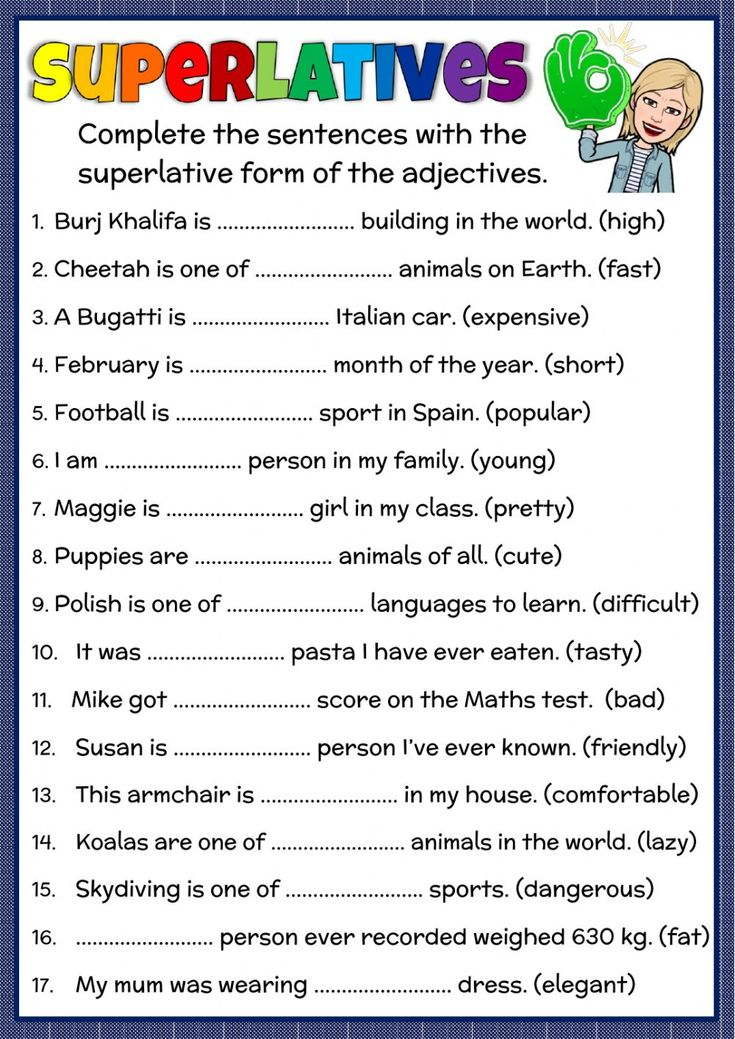
Mastering Superlatives: The Indispensable Role of Superlative Adjectives Practice Worksheets
In the intricate tapestry of the English language, adjectives play a crucial role in painting vivid pictures, describing qualities, and adding depth to our communication. Among them, superlative adjectives stand out, allowing us to identify the absolute extreme of a quality within a group. They help us pinpoint "the biggest," "the smallest," "the most beautiful," or "the least expensive." While the concept might seem straightforward, mastering their formation and correct usage often requires dedicated effort, and this is precisely where superlative adjectives practice worksheets become an invaluable resource.
What Are Superlative Adjectives and Why Do We Need Them?
Before delving into the utility of practice worksheets, let’s briefly revisit what superlative adjectives are. A superlative adjective is used to describe an object that is at the upper or lower limit of a quality (e.g., the tallest, the smallest, the fastest, the slowest, the most difficult, the least difficult). They are typically used when comparing three or more nouns.

The rules for forming superlatives vary depending on the adjective’s length:

- One-syllable adjectives: Add "-est" (e.g., tall – tallest, old – oldest, fast – fastest). If the adjective ends in a single vowel and a single consonant, double the consonant before adding "-est" (e.g., big – biggest, hot – hottest).
- Two-syllable adjectives ending in -y: Change "y" to "i" and add "-est" (e.g., happy – happiest, easy – easiest, noisy – noisiest).
- Two-syllable adjectives not ending in -y, and all adjectives with three or more syllables: Use "most" before the adjective (e.g., modern – most modern, beautiful – most beautiful, intelligent – most intelligent).
- Irregular superlatives: Some common adjectives have irregular superlative forms that must be memorized (e.g., good – best, bad – worst, far – farthest/furthest, little – least, much/many – most).
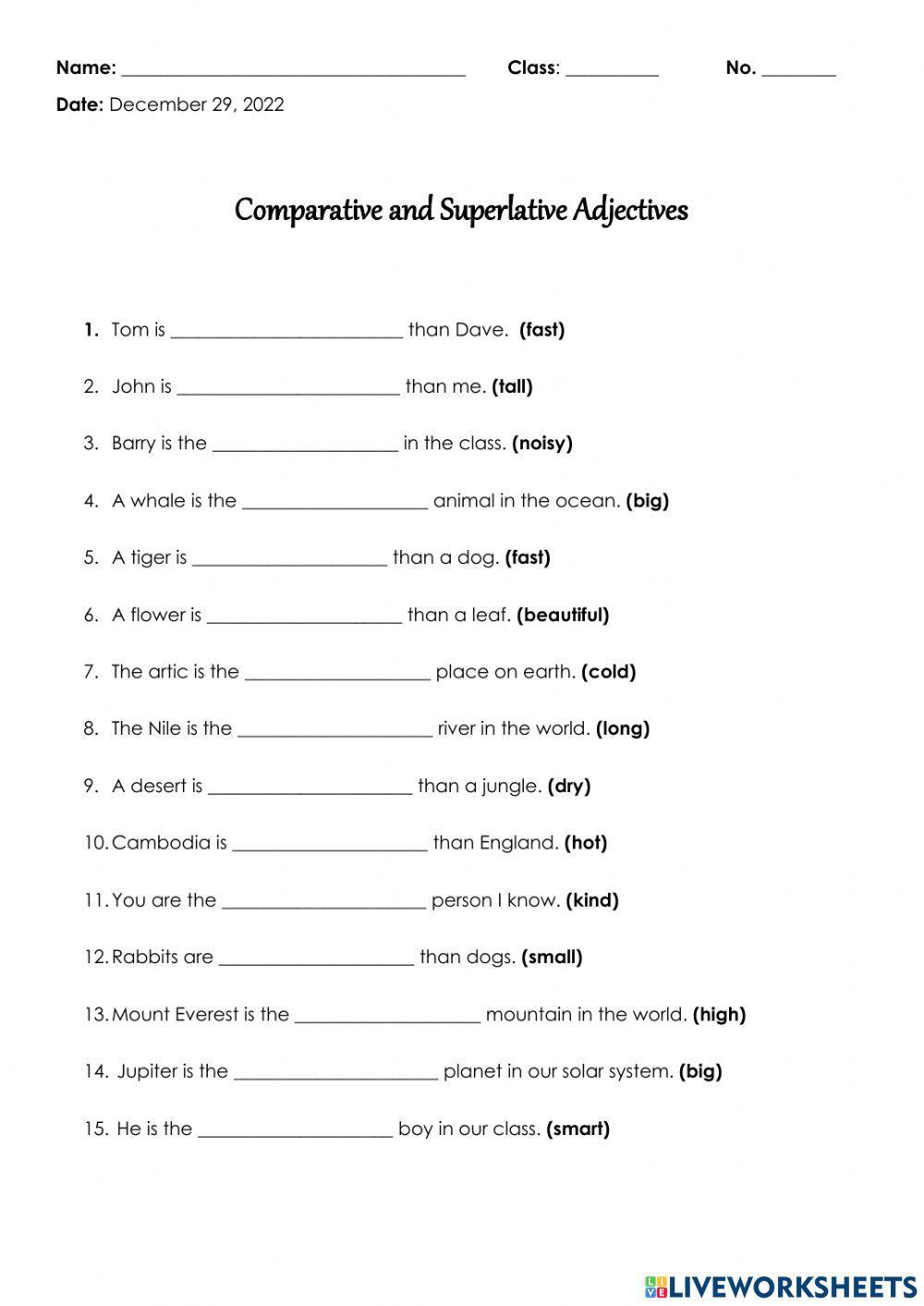
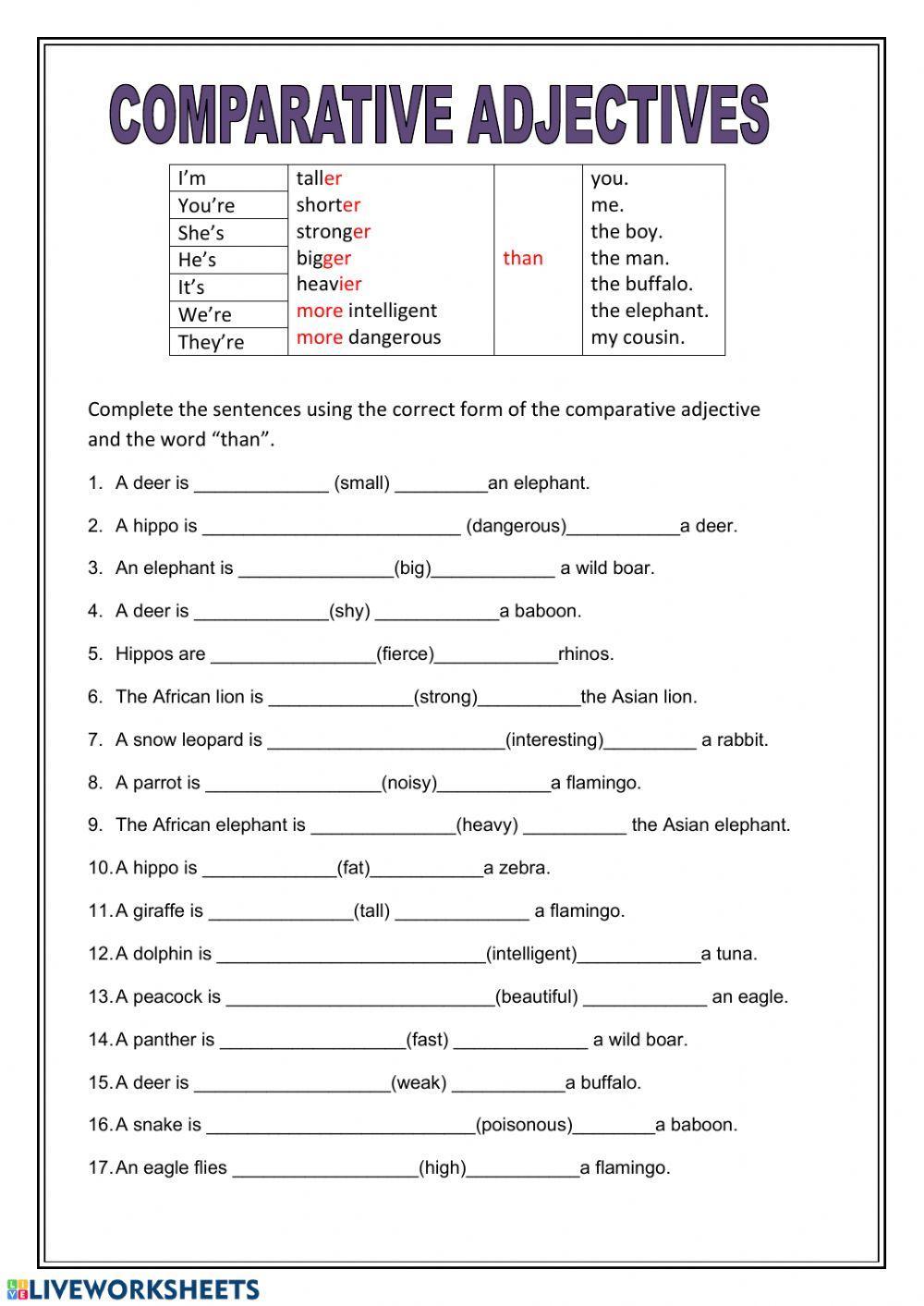

The importance of mastering superlatives cannot be overstated. They enable precision in language, allowing us to make definitive comparisons. Without them, our descriptions would lack the nuance required to express extremes, leading to ambiguity and less impactful communication. From academic writing to everyday conversation, superlatives are a fundamental building block of effective English.
The Unrivaled Benefits of Superlative Adjectives Practice Worksheets
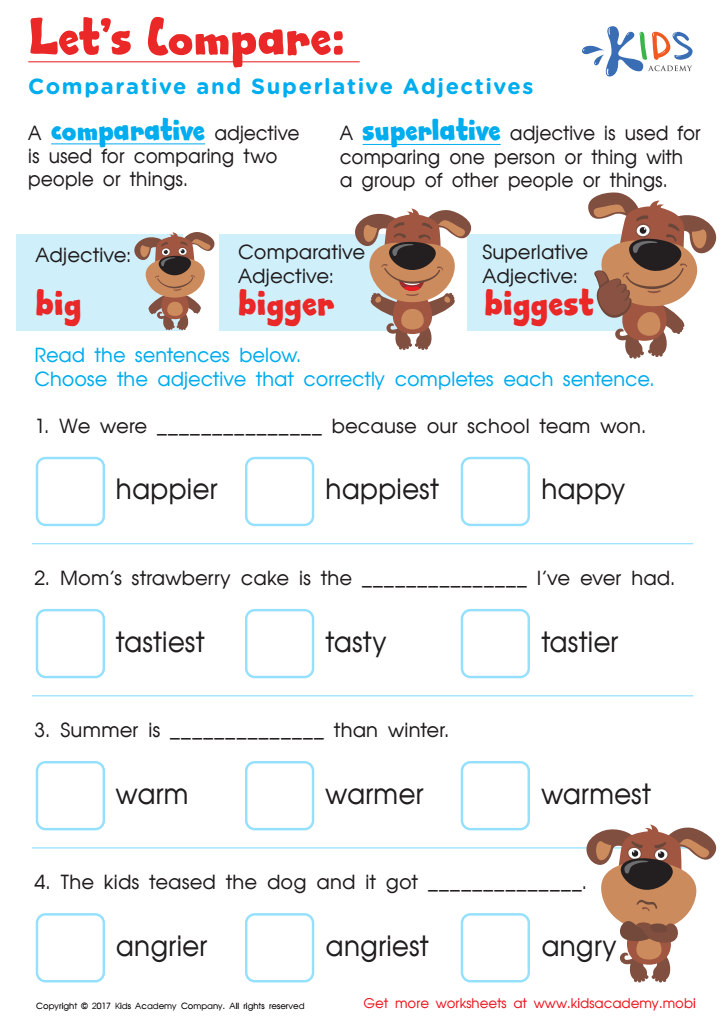
Given the various rules and irregular forms, simply understanding the theory isn’t enough. Active practice is crucial for solidifying knowledge and developing fluency. This is where superlative adjectives practice worksheets shine. They offer a structured, repetitive, and varied approach to learning that caters to different learning styles and levels.
Here are some of the key benefits:

- Reinforcement of Rules: Worksheets provide repeated exposure to the rules of superlative formation. Through filling in blanks, correcting errors, or transforming adjectives, learners internalize the patterns and exceptions. This repetitive practice is essential for moving knowledge from short-term to long-term memory.
- Application in Context: Many worksheets go beyond simple word transformation and incorporate sentences or short paragraphs. This allows learners to see and apply superlative adjectives in meaningful contexts, understanding not just how to form them but also when and why to use them.
- Identification of Common Errors: Worksheets often include exercises specifically designed to highlight common mistakes, such as confusing "most" with "-est," misapplying spelling rules, or overlooking irregular forms. By actively identifying and correcting these errors, learners become more aware and less likely to repeat them.
- Targeted Practice for Irregular Forms: Irregular superlatives are notorious for being challenging. Dedicated sections within superlative adjectives practice worksheets can focus solely on these tricky words, ensuring learners commit them to memory through repeated drills.
- Catering to Different Learning Styles: Visual learners benefit from seeing the words written down and transformed. Kinesthetic learners benefit from the act of writing or typing. Auditory learners can benefit if the worksheets are used in conjunction with a teacher’s explanations or peer discussions.
- Self-Paced Learning: Worksheets allow learners to progress at their own pace. They can spend more time on areas they find challenging and move quickly through concepts they’ve already grasped. This autonomy fosters a sense of ownership over the learning process.
- Assessment and Progress Tracking: For educators and self-learners alike, completed worksheets serve as a tangible record of progress. They can pinpoint areas of weakness that require further attention and celebrate improvements as mastery grows.
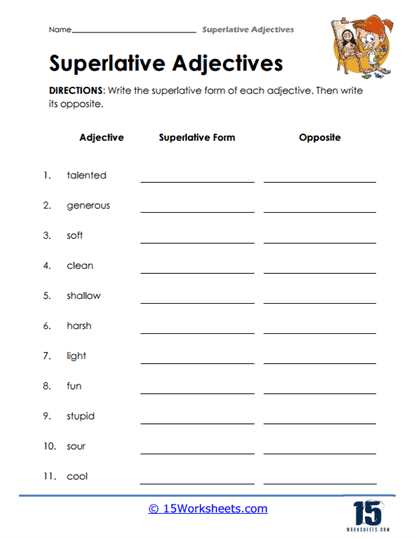
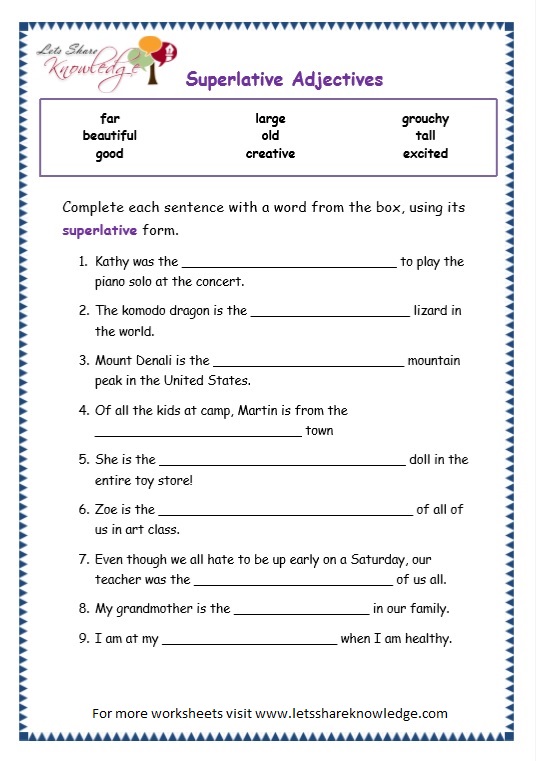
Types of Exercises Found in Superlative Adjectives Practice Worksheets
A well-designed set of superlative adjectives practice worksheets will incorporate a variety of exercise types to keep learners engaged and address different aspects of superlative usage:
- Fill-in-the-Blank: The most common type, where learners are given a sentence with a blank and an adjective in its base form, requiring them to supply the correct superlative.
- Example: Mount Everest is the (high) mountain in the world. (Answer: highest)
- Sentence Transformation: Learners rewrite sentences, changing a comparative adjective to a superlative, or simply incorporating a superlative into a given context.
- Example: Rewrite: "My dog is faster than all the other dogs in the park." (Answer: My dog is the fastest dog in the park.)
- Choose the Correct Form: Multiple-choice questions where learners select the correct superlative form from a given set of options. This is excellent for recognizing correct usage.
- Example: Which is the correct form? a) the most tallest b) the tallest c) the tallerest
- Error Correction: Sentences containing incorrect superlative forms are presented, and learners must identify and correct the errors. This builds critical thinking and attention to detail.
- Example: Correct the sentence: "She is the most intelligentest student in the class." (Answer: She is the most intelligent student in the class.)
- Matching Exercises: Matching base adjectives with their superlative forms, especially useful for irregular adjectives.
- Creative Writing Prompts: Learners are asked to write sentences or short paragraphs using a given set of superlative adjectives or to describe something using at least five superlatives. This encourages creative application and contextual understanding.
- Comparison Charts: Creating charts where learners list the positive, comparative, and superlative forms of various adjectives. This reinforces the relationship between the three degrees of comparison.
- Picture Description: Using images, learners describe objects or people using superlative adjectives (e.g., "This is the smallest car," "She is the happiest child").
Tailoring Worksheets to Different Learning Levels
Effective superlative adjectives practice worksheets are not one-size-fits-all. They should be adaptable to different proficiency levels:
- Beginner Level: Focus on one-syllable adjectives and basic "most" forms. Exercises will be simpler, often focusing on single word transformations or short, direct sentences. Visual aids can be very helpful.
- Intermediate Level: Introduce two-syllable adjectives ending in -y, irregular forms, and more complex sentence structures. Error correction and short creative writing tasks become more prominent.
- Advanced Level: Challenge learners with nuanced usage, distinguishing between "farthest" and "furthest," or using superlatives in more abstract contexts. Exercises might involve analyzing literary excerpts or engaging in debates using superlative forms.
Maximizing the Effectiveness of Superlative Adjectives Practice Worksheets
To get the most out of these valuable resources, consider the following strategies:
- Start Simple, Progress Gradually: Don’t overwhelm learners with too many rules or exceptions at once. Build a strong foundation before introducing complexities.
- Provide Clear Instructions and Examples: Ensure learners understand what is expected of them before they begin.
- Offer Immediate Feedback: Correcting mistakes promptly helps learners understand where they went wrong and why. This can be done by a teacher, a peer, or through answer keys.
- Encourage Self-Correction: Instead of just giving the answer, prompt learners to explain why their initial answer was incorrect and how they arrived at the correct one.
- Integrate with Other Activities: Worksheets are best used as part of a broader learning strategy. Follow up with speaking activities, games, or real-life application opportunities.
- Make it Fun: Incorporate elements of gamification, use interesting themes, or allow learners to work collaboratively on certain worksheets.
Beyond the Worksheet: Integrating Practice
While superlative adjectives practice worksheets are fundamental, true mastery comes from integrating this knowledge into all aspects of language use. Encourage learners to:
- Speak with Superlatives: Create scenarios where they must describe things using superlatives (e.g., "What’s the most interesting thing you did last weekend?").
- Listen for Superlatives: Pay attention to how superlatives are used in movies, songs, podcasts, and everyday conversations.
- Read for Superlatives: Identify superlatives in books, articles, and online content.
- Write with Superlatives: Incorporate them naturally into essays, stories, emails, and social media posts.
Conclusion
Superlative adjectives are a cornerstone of expressive and precise English communication. Their correct formation and application can significantly enhance a speaker or writer’s ability to convey meaning effectively. For anyone looking to solidify their understanding and gain confidence in using these essential descriptive tools, superlative adjectives practice worksheets offer an unparalleled, structured, and effective pathway to mastery. They provide the necessary repetition, contextual application, and targeted focus required to transform theoretical knowledge into fluent, accurate usage. Embrace these powerful learning aids, and watch your command of English reach its highest potential.
